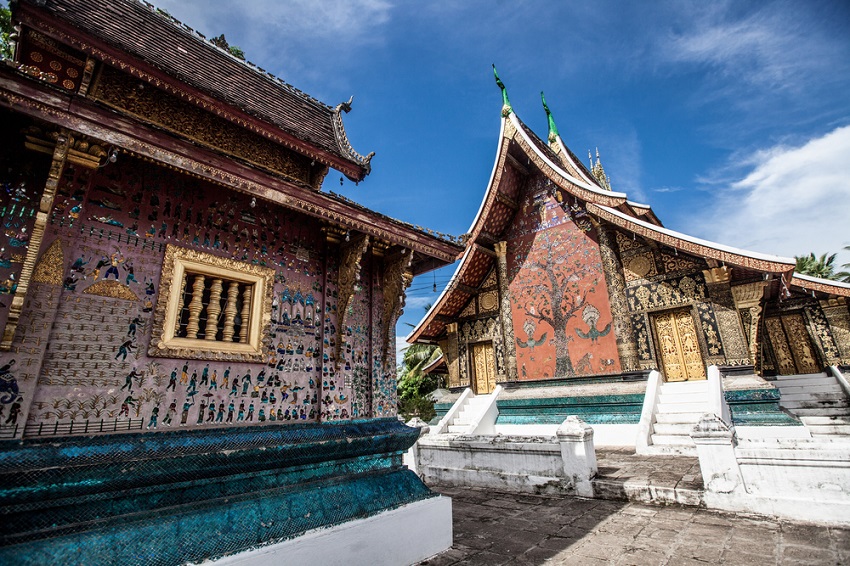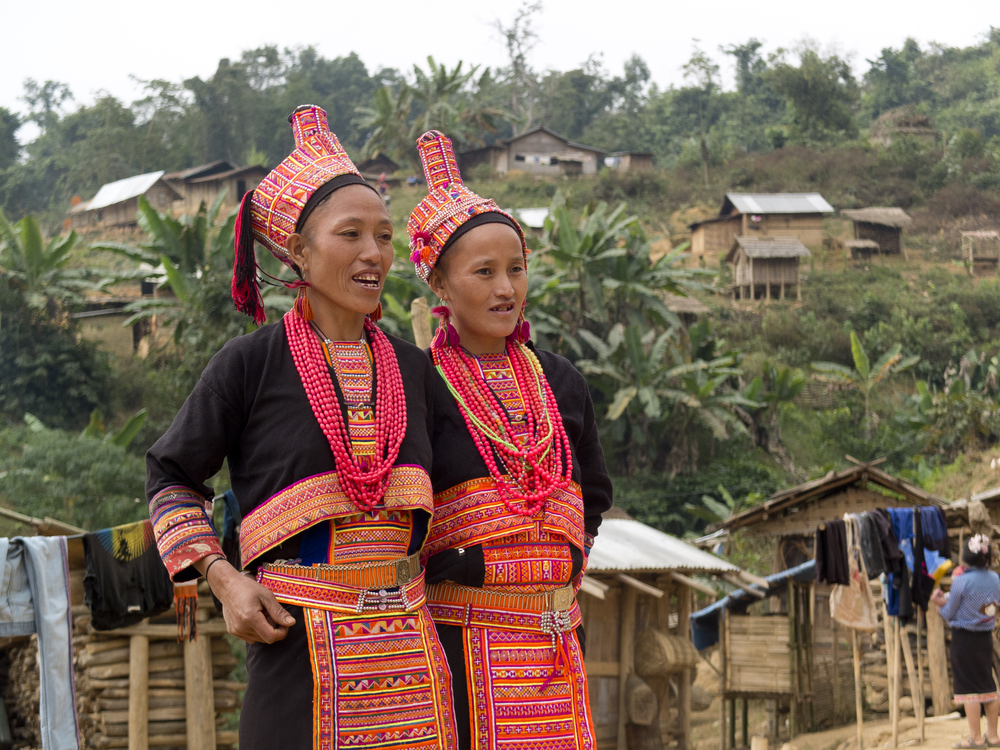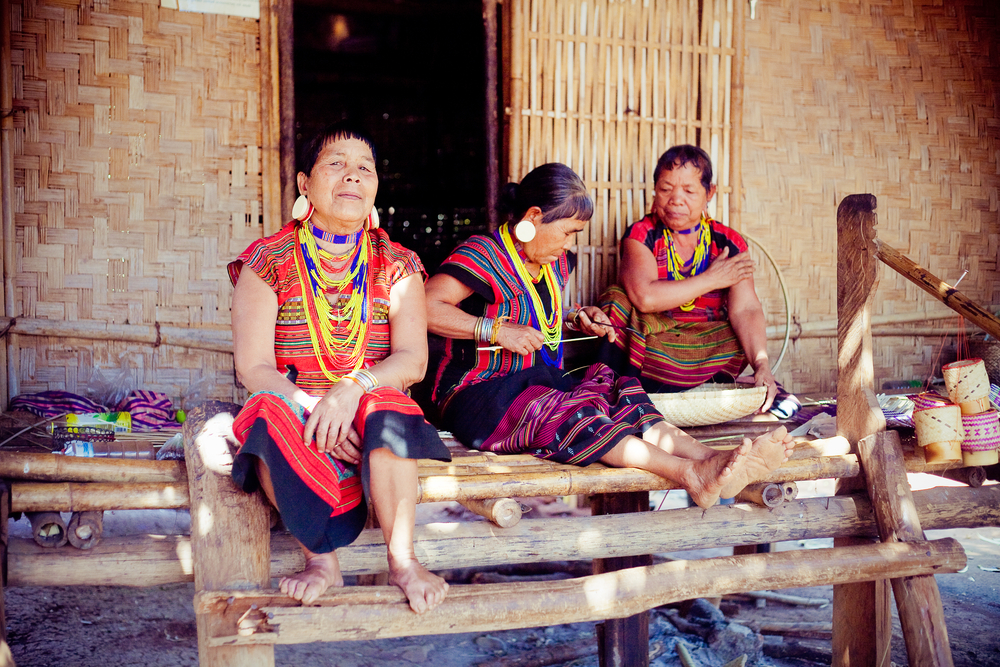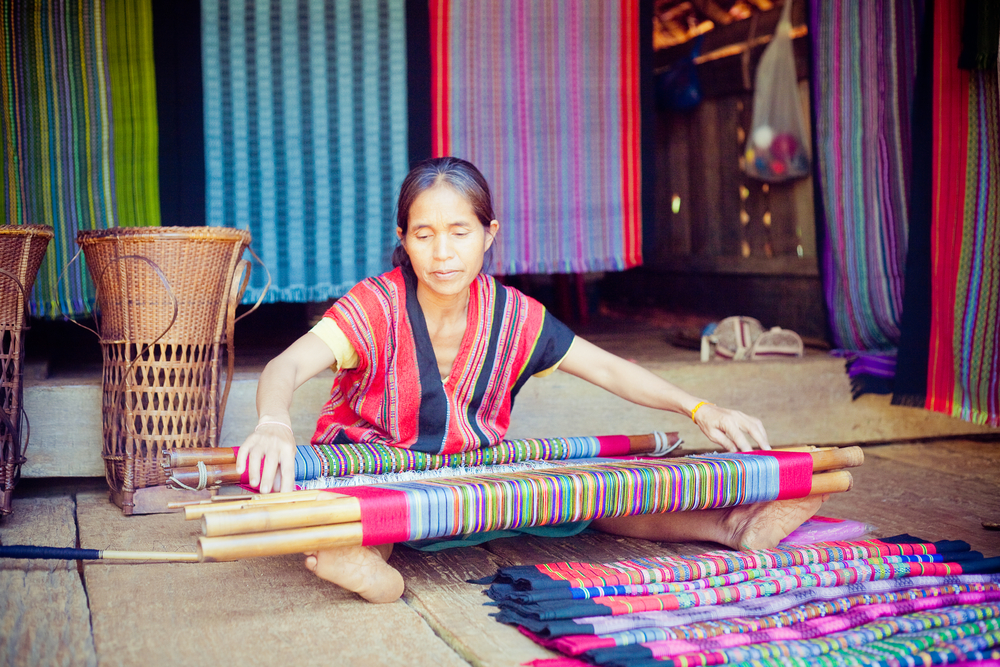Laos - history
Era of Kingdom
How Laos emerged is considered clear when a kingdom was established at Xeing Dong Xieng Khong or Luang Phrabang with an assumption that it had been a capital of power to those speaking Mon-Khmer language before falling into the hands of Laos. History of Laos believed to begin when Prince Ngum, a descendant of Khun Lor, a son of Khun Borom, established Lan Xang in 1353 ( ธีระ นุชเปี่ยม ใน สำนักงานราชบัณฑิตยสภา, 2558, น.100). His oldest son, King Samsaenthai, succeeded the throne and ruled for 43 years. it is a turning point when he died wreaking conflicts in Lan Xang all along. The kingdom faced ups and downs. When King Phosathirat stayed in power, it was introduced to Buddhism from Lanna bringing about glorious Buddhism, arts and literature. In King Chaiyachetthathirat period deemed as the golden age of Lan Xang with the capital city being removed from Luang Phrabang to Vientiane in order to avoid Bago’s increasing influences, the kingdom grew a good relation with Ayutthaya. However, the glorious days did not last by the end of King Suriyavongsathammikharat. By 1699 Lan Xang was broken into 3 independent kingdoms, Laung Phrabang in the north, Vientiane in the central and Champasak in the south. The internal and external conflicts continued with 15 conflicts in a course of 84 years that saw 11 internal conflicts. (สุวิทย์ ธีรศาศวัต, 2543, น.413)
Eventually, the three kingdoms of Laos fell into being vassal states of Thailand by 1779 for 114 years (1779-1893). Under Thai rule, Laos did not change its own administration, laws, and budgets, tax collecting, judiciary and ways of Lan Xang life. Thailand always pleased Lao elites while having levies in return. (สุวิทย์ ธีรศาศวัต, 2543, น.414-415) A major resistance of Laos to Thai regime is when King Anouvong declared independence and marched from Vientiane attacking Isan region to Saraburi. Thailand struck back very severely, thus, King Anouvong turned to Vietnam. He later came back and occupied Vientiane with a help of Vietnamese forces. Thailand, then, struck back and conquered Vientiane. The war caused tremendous damages to the city and led to an international conflict between Thailand and Vietnam. It developed to a war of power in Laos between Thailand and Vietnam, which continued to the colonial times. Lao economy under Thai rule was in a form of exchanging goods within closer communities. International trades occurred in big cities nearby Mekong River as Lao and Isan merchants regularly crossed the river, while European goods travelled by boat through Uttaradit Province and were carried by elephant to Luang Phrabang. The obstacles of transportation at that time was islets in Mekong River, mud-hole roads, malaria fever and thieves. (สุวิทย์ ธีรศาศวัต, 2543, น.416-417)
Colonial Period
France started expanding its power to Indo-China in late 19 century as it occupied Laos and Vietnam and established those as French Indochina in 1887. The Thai border connecting Laos now was close to the French colony. (ธีระ นุชเปี่ยม ใน สำนักงานราชบัณฑิตยสภา, 2558, น.105) Groups of thieves plundering around Thai-Vietnamese borders had been chronic and both countries was trying to put them down from time to time. This problem continued under French rule, so France and Thailand cooperated and push those thieves out of Laos and Vietnam. However, as a consequence, France did not retreat from Lai Chau claiming that this land had been part of Vietnam. It gave birth to the Franco-Siamese treaty at Dien Bien Phu allowing France to temporarily set up their base there. France later asked and explored Laos so that they would draft territories. Thailand thought it this action would lessen territorial conflicts so agreed to do so. August Pavie, a French Chancellor of Luang Phrabang in 1886, played a vital role in drafting the territories. He had begun exploring Mekong River 16 years earlier by walk, elephant and raft in which it reached out to 30,000 kilometers with as estimated area of 627,000 square kilometers from Siamese gulf to the present Indochina. There were many groups of explorers at that time whose title was called ‘Pavie’. ( ธีระ นุชเปี่ยม ใน สำนักงานราชบัณฑิตยสภา, 2558, น.108-109) France later claimed its rights over those lands because once they had been under Vietnamese rule demanding Thai forces be removed out of the left side of Mekong River. They also used their forces for pressuring Thailand leading to the Franco-Siamese treaty on 3rd October 1983. Lands on the left side of Mekong River or Laos were surrendered to France.
When France took over Laos, it became part of Union Indochinoise with the French high commissioner being in charge in Hanoi and directly reporting to Colonial Ministry in Paris. Laos had a regent in Vientiane. For the federal government, France acted as Head of Division, while the local government was broken into 10 districts with French governors each. Every district had a capital city that a French-appointed city ruler was in charge. However, France never allow any Lao king residing in Laung Phrabang to act as Head of State practically and figuratively. It, instead, brought Vientiane back to life and made it the center of administrative power. The French-directly ruled system in each district covered every sphere regarding judiciary, taxing and Public Works Department recruiting and employing some Vietnamese staff. On the contrary, the Lao worked in lower divisions. France took a special interest in emancipation and taxing. The emancipation in Laos was considered a French burden contributing to improvements, while taxing was increasing and upsetting the Lao. It imposed high taxes and labors causing trouble for the Lao, therefore, the people continued resisting on both North and South. Laos during that course of time developed public work affairs, public health, education and transportation, but its economy did not improve. The French regime vividly raised awareness in terms of education and culture leading to constructing nationalist consciousness among Lao elites. In Vientiane, Pha That Luang and Wat Phra Keo were reconstructed with helps of École française d'Extrême-Orient as well as the exploration and restoration of Wat Phu in Chapasak. (ธีระ นุชเปี่ยม ใน สำนักงานราชบัณฑิตยสภา, 2558, น.119) Standardizing the writing system of Lao language and restoring Buddhism in Laos somehow did raise awareness though Buddhism was slightly affected by the French regime. The Lao people did not take an interest in Christianity as they still clung on Buddhism. The studies of history, literature and culture and various subjects of discussions under the French regime contributed to and encouraged nationalism that placed a highlight on culture in Laos. When the Second World War broke out in Europe and France was defeated, its power in Indochina weakened. Japan occupied Laos imposing even more taxes and labors and it resulted in Lao Issara or Free Laos movement against imperialism. As Japan surrendered the Allies, France came back and sent troops to Laos again. The Lao Issara movement was leading in fighting against France, but finally lost the battle in which they crossed the border and establish a governemtn in exile in Thailand. Pridi Banomyong, Thai government’s leader at that time, supported the movement financially and also supplied weapons. Unfortunately, the government in exile had to cease. Some of the Lao Issara members chose to flee to woods instead of turning themselves to France. When France started losing its momentum in the Indochina war, it was pressured by the US government to proceed the requests made by a group of nationalists in Indochina. The US demanded France allow more autonomous power to Laos, while the aggressive Lao Issara members split and formed their revolutionary organization called Free Laos Front with a government called Laos Country. The Lao communist organization was successfully established, yet a communist party was not founded. It led to seizing and releasing 2 districts of Laos, Xam Nuea and Phongsali, as a result, it was the first time Laos ever had its own autonomous territories. On an Indochina scale, other countries were struggling for independence as Vietnam forces fatally attacked Dien Bien Phu, the biggest French base in Indochina. France had surrendered on 8th May 1936 before completely retreating from Indochina according to Geneva Accord on 21st July 1936. The meeting acknowledged Lao independence so that Laos could achieve its own sovereignty and determine its future politics with a general election in 1937.
Lao’s People Democratic Republic - Present
Laos enjoyed the independence and democratic ways for a brief period of time when the election and the government were solidified. However, Lao political conflicts led to a more serious matter and broke into 2 major sides. The right wing had Vientiane as a center with the mighty US supporting, while the left wing or Laos Country had Xun Nuea as a center with socialist countries, especially Vietnam, supporting. The right wing split up and had 10 different governments over the course of 20 years after Independence Declaration. (สุวิทย์ ธีรศาศวัต, 2543, น.424) As the US retreated from Indochina, the battles ended with a communist victory. The right wing in Laos felt threatened with Lao political unrest. The left Lao Country, thus, seized absolute power and formed a government led by Lao’s People Revolutionary Party on 2nd December 1975. A change in regime from kingdom to communism-socialism introduced Lao’s People Democratic Republic. Prince Suphanouvong was President and Kaysone Phomvihane was Prime Minister. The current Lao constitution promulgated in 1991declaring Laos as a Marxism-Leninism socialist republic celebrating its ideology and a one-party regime that is Lao’s People Revolutionary Party. It calls itself a regime of democracy by the people. (ธีระ นุชเปี่ยม ใน สำนักงานราชบัณฑิตยสภา, 2558, น.136)
Early days of the new regime saw the exercise of absolute power that was too rapid and radical when an attempt made by the party to take control over administration and economy was not promising the national reconciliation. On the contrary, it instilled doubts while forcing what was called “Lao Socialist Culture”. All of the high-ranking officials were removed to Viengxay in order to join political seminars, while the lower-ranking officials still working were called to meetings in order to study the new political directions and criticize the former government. In addition, some citizens were demanded to join those so-called meetings casting fears and doubts in the society. Laws strictly enforced on individual and economic levels. The people were encouraged to get exposed to the avant-garde ideology, but publishing houses were closed in a response to strictly controlling information. People in rural areas were physically forced by soldiers to join the meetings. Government employees were encouraged to participate in working in small sectors as the party decided to close the country. Western nations stopped helping Laos except the communist nations like Soviet Union partially providing financial aid. This led to its economic collapse. Buddhism all the while was pressured by the party’s policies in trying to sabotage the Buddhist monk’s creditability. Those did not allow Buddhist rituals and harass the monks’ activities such as going about for food offerings. Nonetheless, they demanded the monks produce anything resonating to Marxist ideology. (สจ็วต-ฟอกซ์, มาร์ติน, 2553, น.351-353)
However, Laos has improved so many aspects over the past 30 years after the government introduced the new socialist direction called a policy of new imagination in 1986. This policy later turned to a reform aiming at connecting Lao economy to global capitalism in order that it could rapidly grow. ( ธีระ นุชเปี่ยม ใน สำนักงานราชบัณฑิตยสภา, 2558, น.136) In terms of society, culture and ways of life, the government appeared loosened and more compromising. In addition, Martin Stuart-Fox gave his opinion on regionalism which was the mainstream of the 1990’s in reinventing power in Southeast Asia that Laos was part of dynamics and this regional cooperation.
“In April 1994 the first bridge across Mekong River between Thai-Lao borders officially opened implying a symbol that was not only a pinpoint opening a new era of Thai-Lao friendship but also included Laos as part this region. Thai investments were the most valuable forming economic influences similar to Vietnamese influences in Laos. The opening to Thailand did not mean Laos had stepped back to be a buffer state among the powerful neighboring countries but rather an increase in trades and tourism with ASEAN and western countries. Innovative and new ideas introduced to Laos might have had difficulties establishing themselves. In the mid 1990’s Laos saw a more powerful influence on a global scale that was not international conflicts anymore. It was how a country could develop its economy to be more modern and more integrated in that region.” (สจ็วต-ฟอกซ์, มาร์ติน, 2553, น.410)
Lao politics now has achieved the stability under Lao’s People Revolutionary Party and the government led by Thongsing Tummavong took a special interest in getting rid of corruptions and in supporting young leader roles. Laos had a cabinet shakeup in order to solve problems regarding budgets in March 2014. Later in July 2014 two Deputy Prime Ministers were appointed along with a minister of Ministry of Defense and a minister of Ministry of Peace Defense in replacement of the dead in fatal plane crash in May 2014. It reflects how the power is transferred from the old to the new leaders in the 10th meeting of the party early in 2016.
Lao directions regarding improving the country over the next five years have the government aim at lifting Laos above the under-developed country bar within 2020. Meanwhile Laos has open policies balancing international relations with countries like Japan and the US so that this would lessen Chinese and Vietnamese influential power. It has prepared to become the Secretary-General of ASEAN countries in 2016. Moreover, Lao national council approved the law against terrorism and terrorist financial aid in July 2014 in order to prevent laundering and terrorism. It has fulfilled a role of a WTO member according to UN obligation. However, Laos is facing challenges (1). Economic problems such as lower national revenues, suffering trade losses, cost of living and inflation risking economic crisis. (2). Social problems such as drug invasion, human trafficking, corruption and income inequality. The Lao society started criticizing the government administration seen from economic and environmental problems and human right violations, while Cambodia, Vietnam and international private organizations are opposed Lao building a dam at Mekong River. (สำนักข่าวกรองแห่งชาติ, 2557, น.370)
Bibliography
ธีระ นุชเปี่ยม.(2558). สาธารณรัฐประชาธิปไตยประชาชนลาว. ใน สำนักงานราชบัณฑิตยสภา (น.97-139). กรุงเทพฯ: สำนักงานราชบัณฑิตยสภา., สารานุกรมประวัติศาสตร์ประเทศเพื่อนบ้านในอาเซียน ฉบับราชบัณฑิตยสภา
สจ็วต-ฟอกซ์, มาร์ติน. (2553). ประวัติศาสตร์ลาว (จิราภรณ์ วิญญรัตน์, ผู้แปล/ กาญจนี ละอองศรี และ ปรียา แววหงษ์, บรรณาธิการ). กรุงเทพฯ : มูลนิธิโตโยต้าประเทศไทย
สำนักข่าวกรองแห่งชาติ. (ธันวาคม 2557). ข้อมูลพื้นฐานของต่างประเทศ 2558. สืบค้นเมื่อวันที่ 15 กันยายน 2558, จาก https://www.nia.co.th/niaweb58/data_gb.asp.
สำนักงานราชบัณฑิตยสภา. (2558). เพลินภาษาเพื่อนอาเซียน ฉบับราชบัณฑิตยสภา (พิมพ์ครั้งที่ 2). กรุงเทพฯ: สำนักงานราชบัณฑิตยสภา.
สุวิทย์ ธีรศาศวัต. (2543). ประวัติศาสตร์ลาว 1779-1975. กรุงเทพฯ : สร้างสรรค์.





